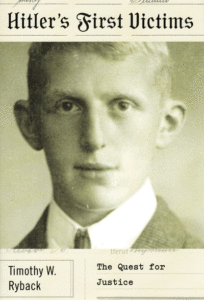Hitler’s First Victims: The Quest for Justice, by Timothy Ryback, Knopf, $26.95
Reviewed by NEAL GENDLER
Stranger than fiction: In spring 1933, a Bavarian prosecutor obtained indictments against SS members for the murders of four prisoners at Dachau.
Timothy Ryback’s Hitler’s First Victims is a short, fascinating, disturbing story of an honest man’s courage and of the treatment of Nazi Germany’s first concentration camp victims — political prisoners shot or beaten to death for no apparent reason but the sadistic enjoyment of their tormentors.
The hero is Josef Hartinger, then 39, deputy prosecutor for a large area near Munich in which the Nazis created their first concentration camp in an abandoned World War I ammunition plant.
Hartinger’s notes and files are “some of the earliest forensic evidence of the systematic execution of Jews by the Nazis,” says Ryback, who also authored Hitler’s Private Library: The Books That Shaped His Life and The Last Survivor: Legacies of Dachau.
Ryback learned of these early Dachau murders during a New Yorker assignment in the 1990s. Two Germans previously had written of them, and Ryback thought there was little to add until he discovered Hartinger’s “unpublished, and seemingly forgotten, account.”

Hartinger saw the Nazi regime’s growing consolidation of power, but after four chancellors in 10 months, he thought Hitler also wouldn’t last, Ryback says. Hartinger, part of the “first generation of state prosecutors trained in the processes and values of a democratic public,” had pursued Communists and Nazis with equal vigor.
The law required police to report any case in which “a person has died from causes other than natural ones,” and the prosecutor to investigate “until he has determined whether an indictment is to be issued.”
Suspecting SS accounts immediately, Hartinger investigated the camp deaths as homicides, getting proof from autopsies by an equally courageous medical examiner, Dr. Moritz Flamm.
Most of the victims were Jews, including the first four, shot at close range — allegedly while attempting escape. One still alive was taken to a hospital where he told the real story before dying. As weeks went by, increasing numbers of men taken into “protective custody” for real or alleged political opposition were driven to Dachau by state police, one of whom told a prisoner: “As long as we are on guard here, nothing will happen to you, but if we leave, you will be in trouble.”
Police originally ran Dachau, but the SS soon kicked them out and the abuse began. Prisoners were beaten day after day and shot at the whim of the commandant and SS men — especially one Hans Steinbrenner, head of the camp’s whipping staff. Deaths were recorded falsely as suicides, escape attempts and attacks on guards.
Hartinger’s first prosecution requests were rebuffed, but as the killings continued, he decided to take four cases “with incontrovertible evidence” for indictments “with the intent of demonstrating a pattern of deaths that suggested the intentional serial killing of detainees with possible chain-of-command involvement.”
Hartinger indicted “unknown perpetrators” (he had three in mind) for murder and the camp’s SS physician, office administrator and commandant for aiding and abetting the killings.
The indictments rose all the way to Hitler, who quashed them. But 12 years later, they were introduced at the Nuremburg trials to help criminalize the SS.
Ryback is an excellent writer, and the pages fly by, though not without upsetting details of the sadistic killings. The cover photo is of Wilhelm “Willy” Aron, a 25-year-old Jewish junior attorney from Bamberg, who was beaten to death by Steinberg and crew.
Hitler’s First Victims reminds us of things now little known. One is that President Hindenburg opposed Hitler’s anti-Jewish policies and more than once admonished him, even getting Jewish veterans restored to their civil-service positions. Another is the extent of the turmoil in Germany after its 1918 defeat. For a time, Bavarian Communists proclaimed a state, setting off a civil war with atrocities that Hartinger was determined to prevent recurring.
He couldn’t, but unlike many Germans, who remained passive or frightened, he tried. Ryback’s book is a decades-overdue and well-deserved recognition.
***
Neal Gendler is a Minneapolis writer and editor.
(American Jewish World, 10.24.14)



















